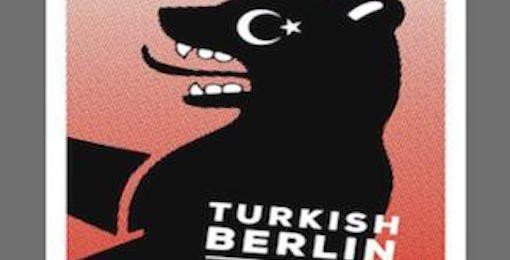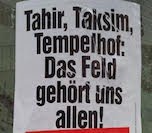Jadaliyya interviewed Annika Marlen Hinze on her book “Turkish Berlin: Integration Policy and Urban Space” published by University of Minnesota Press.
Jadaliyya: What made you write this book?
Annika Marlen Hinze (AMH): I grew up in Berlin in the 1980s, which means I grew up amidst many public debates about "foreigners" and "immigrants." Yet, as someone who was never visibly different in any way, I never really considered how central the immigration debate, and the situation of German Turks, is to German politics and society, until I moved to Chicago. This move changed me profoundly. I realized that the longer I lived in the US, the more I also became part of this society, yet I will always remain a German in certain ways. Through my personal experience as an immigrant, I started to get a first-hand understanding of how many German-Turks feel similarly torn. Many feel like they belong to two different countries, but are never quite at home anywhere.
Secondly, in Chicago, which has a large Hispanic minority, I became acutely aware of minority politics. I don't want to say that the treatment of immigrant minorities is really that much better in the United States than it is in Europe. The current immigration debate (and the recent "birther movement" questioning President Obama's US identity) shows that xenophobia is certainly not dead in this country. But many German Turks feel that they will forever remain Turks in the eyes of Germans, despite the fact that they were born in Germany, hold German citizenship, and speak native German. This is much less the case here in the US, and that difference intrigued me. So, in a way, the comparative perspective I gained by living in Chicago made me more interested in Berlin. And even though this project really started out as a dissertation, I knew right away that I wanted it to eventually be a book.
What particular topics, issues, and literatures does the book address?
The book touches on many different issues. It introduces the reader to the basic ideas and historical developments of citizenship and identity in Germany throughout the twentieth century. Just as in the United States, the historical background on national identity is very important to understanding current immigration debates in Germany. The book also deals with immigration and identity, tackling more theoretical questions regarding group and individual identity, and why certain ethnic and cultural symbolisms are so important to national identity.
But really, the book is about Berlin, and what is happening on the local level. It deals with local immigration and integration policy, engaging the different frames policy-makers apply to their definition of "successful integration." My goal is to understand whether policy approaches are based on social realities in immigrant neighborhoods, and the real issues that German Turks face in the integration process. A special emphasis is on how "integration" is framed in policy discourse, and how immigrants themselves define it. I find that policy makers have vastly different ideas regarding integration, with some more closely based on social realities than others.
I also find that, like Chicago, Berlin is a city of neighborhoods. Many immigrants define their identity based on their neighborhood rather than based on their passport, native language, or ethnic heritage. The socio-economic and cultural character of the different neighborhoods that German Turks reside in has a huge impact on how "at home" they feel in them. So, in many ways, integration is a micro-level process that takes place in the neighborhood. Neighborhood identity becomes a way for many German Turks, who feel that they belong neither in Turkey nor in Germany completely, to appropriate an in-between identity.
This is facilitated by the extremely decentralized administrative structure of the City of Berlin. The city’s twelve districts administer their own “integration policy” (a very German way of referring to the socio-cultural assimilation of immigrants). In my book, I looked at two city districts with the highest percentage of immigrants, in order to see whether German Turks in different local districts identify in different ways with their localities. I found that one district, Kreuzberg-Friedrichshain, which has a long-established tradition of grassroots movements and protests, seems to be a much stronger local source of identity than the other, Neukölln, which puts much more funding and highly publicized effort into integration policy. This is not to say that strong policy efforts at integration do not work. The integration efforts in Neukölln only started in earnest in 2006 and are too recent to draw any conclusions regarding their effectiveness. However, it seems that the long-established tradition of grassroots movements and protests in Kreuzberg does have a strong influence on immigrants as well, and their perception of their ability to be a source of change.
This, I think, is one of my key findings: German Turks in Kreuzberg feel that they can be influential on a local level, which helps them identify with the locality in which they live. However, things are in flux, and Kreuzberg is also heavily gentrifying. This is already having an effect on its German-Turkish community: only the well-to-do ones can afford to stay—the rest will eventually be pushed out to more affordable neighborhoods. So a question for future research would revolve around whether there are really two groups of German Turks: the well-to-do ones with a political voice, and those without one. And do they work together?
How does this work connect to and/or depart from your previous research?
This is my first book, so it is also my first major research project. My previous research was probably a lot less about policy, and much more political theory-focused. For instance, a lot of my previous work was based on citizenship policy and theory, as well as identity politics. This book really focuses on how policy impacts those it is aimed at. It is also very focused on the city, and, as most urban-focused research, very interdisciplinary in nature. Of course, it is very much based in political science, but it also draws massively from sociology and anthropology. It is also primarily based on personal interviews, which was definitely more challenging but also more rewarding than my previous work. I have learned so much from all my informants!
Who do you hope will read this book, and what sort of impact would you like it to have?
I hope that this book will be of interest to scholars of immigration and urban scholars in the US (because its conceptual framework is very much based on political and sociological concepts developed in the United States), but I also hope that it will reach a wider audience in Europe, and particularly in Germany. And, since it is a very policy-focused book, I hope that some policy makers on both sides of the Atlantic might take some interest in it as well. I certainly think that immigration and citizenship policy—and, importantly, local approaches to integration and assimilation—remain very important topics on both sides of the Atlantic, for scholars and practitioners alike.
What other projects are you working on now?
I am currently working on several different projects, all of them very city-based.
I have become very interested in urban development and gentrification. In the United States (and to a lesser extent in Europe), the 1990s have marked a movement of wealthy suburbanites and economic development "back to the city." This has been very good for cities financially, but it has also caused the displacement of many poorer communities from their neighborhoods. We are now seeing similar developments in cities in the East and the Global South. I am currently working on a project in which I compare the effects of urban development and the use of eminent domain on local neighborhood residents in the United States to similar processes in Germany. I am particularly interested in the implications that urban development decisions have for democratic practices in those countries on a local level.
Furthermore, I am working on a project on German Turkish "return migrants" in Istanbul. Since 2007, there has been a small wave of "return migration" from Germany to Turkey, which is gaining momentum. "Return migration" is in quotation marks here because it is actually kind of a misnomer. German Turks are not "returning" to Turkey, because those who end up moving "back" are actually of the second and third generation, which means they, and in some cases even their parents, were born in Germany and have never lived in Turkey. A majority of those German Turks move to Istanbul, Turkey's largest city. They are mostly highly skilled, university educated, and speak several languages. I spent the summer of 2012 in Istanbul conducting interviews with some of those "returnees" about their motivations to return, and whether the reality of life in Turkey meets their expectations. Many find that they are more German than they expected, and that there are certain things about life in Turkey that they feel unfamiliar with. They also feel that they are not often welcomed with open arms and in some cases remain "Germans" in the eyes of local Turks, outsiders to society.
With the recent developments in Turkey, this research project has become even more relevant. Many German Turks tried to explicitly abstain from political involvement when they first came to Turkey, saying that they didn't want to know "too much" about politics and didn't even like watching the news. The outpouring of sympathy and protests this past summer in Germany for the Gezi Park movement goes to show, however, that recent developments have really awoken the Turkish diaspora to take a stand in Turkish politics, via social media alerting the international community to what is going on. And of course the events in Istanbul, which started as a small protest against yet another one of Erdoğan's urban development projects in Istanbul, echo with my research regarding urban development and local democracy and the increasing relevance of the urban context for national politics.
How does your work contribute to and/or diverge from previous works on the Turkish diaspora?
My work examines the ties that bind the second generation of German Turks to the local neighborhood. In other words, it focuses on the interaction between identity and neighborhood space—within the context of local policy and the socio-economic and cultural character of the neighborhood. In that sense, it is embedding the topic of integration and immigrant identity in the urban context. This is something new. At the same time, my work strongly relies on established work on Turkish immigrant identity by Ayşe Çağlar and Patricia Ehrkamp, as well as on citizenship and identity politics—for instance, by Richard Alba and Victor Nee, Zygmunt Bauman, and Manuel Castells.
* This interview originally appeared on Jadaliyya.





